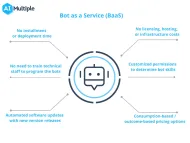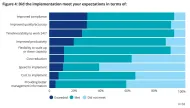5 Ways RPA Contributes to Operational Excellence in 2024
Operational excellence (OpEx) is the general doctrine of implementing broad strokes of “excellence” throughout an organization to improve efficiency, sustainability, quality and profitability.
The use of RPA in operational excellence initiatives can help companies increase their operational efficiency by automating mundane and repetitive tasks that are time-consuming and error-prone.
In 2020, 9/10 “top businesses” claimed to have had an ongoing investment in AI. We believe that increased RPA adoption can improve companies’ operational excellence and, by extension, their financial and operational outlooks.
This article explores:
- What operational excellence is,
- Operational excellence’s five principles,
- RPA’s role in operational excellence.
What is operational excellence (OpEx)?
Operational excellence is a general mindset within a company to increase the efficiency and the “excellence” of a company’s processes and outputs.
According to Juran’s Model1 , there are five key principles of operational excellence:
- Having a clear framework for processes and their standards
- Moving company culture towards prioritizing customer experience
- Monitoring performance metrics and knowing when to intervene
- Allowing for change management to take place seamlessly
- Increasing process effectiveness and agility
We believe that RPA can play an important part in each of these five key principles. However, the first principle might not be handled by RPA alone, so it would require integration with process mining.
How does RPA in operational excellence work?
1. Illuminating and enhancing processes
Enterprises use process discovery and process enhancement, subcategories of process mining, to improve processes (38% and 28% respectively).
Oftentimes, companies want to automate processes but lack insight into their inner-workings. Not having a clear view of your as-is processes stops you from realizing OpEx’s first principle.
Process mining tools can act as de-facto x-rays, showing you how your processes function by gathering event logs data and laying out the interconnections. Once processes are transparent, RPA technology can be leveraged to automate those processes that meet the criteria for automation – remember that not all processes are suitable for RPA automation.
Note: Process improvement methodologies can also help improve processes. However, recent BPM trends show that companies increasingly prefer process intelligence tools, such as process mining and task mining over these techniques.
2. Improving customer experience
RPA can be used in customer service to automate the handling of everyday customer requests to provide a more seamless and superior customer experience. For example, RPA and NLP integration allows bots to read through customer complaints to prioritize and sort them for easier accessibility.
In other instances, customer service RPA-enabled chatbots can be leveraged to automate responses to FAQs or simple enquiries, such as getting product and shipping information, which would otherwise have to be handled with reps.
RPA can also extract data from a customer’s purchase history, customer journey, and browser cookies to create profiles for each customer and allow personalization automatically. 80%2 of customers are more likely to purchase when a brand offers personalized recommendations. And RPAs are a tool that can do it.
3. Monitoring KPIs
RPA bots can monitor processes and workflows to provide managers with transparent KPIs.
For instance, RPAs can partially automate some of the employee onboarding processes, such as:
- Job posting
- Resume screening
- Data extraction from resumes
- Reaching out to candidates
- Scheduling interviews, and more.
For each task that an RPA bot does, it leaves a digital footprint. The performance can be shown on real-time dashboards to provide the HR department, for instance, of how well they are doing. Also, it can show the number of resumes the bot has successfully screened or the number of interviews the bot has automatically scheduled.
The real-time KPI updates allows managers to remedy inefficiencies as they are observed on the dashboard.
4. Automating change management
A 2021 survey3 of 2,000 American full-time and part-time employees showed that ≈45% of them don’t feel their feedback leads to organizational change within a company. In addition, two out of five company executives, too, felt their feedback didn’t lead to meaningful change.
Listening to employee feedback is a direct way of knowing what isn’t working at your company so you can remedy it.
RPA bots can automate change management to:
- Facilitate how employees submit their change requests,
- Increase the speed at which they are evaluated,
- And improve change implementation.
RPA bots can quickly extract the data employees submit on change request forms, read and understand its content and context, conduct a preliminary assessment to determine if it merits more thought, and send it to the relevant department.
The bots can also automate the scheduling of meetings with the proponent, as well as extract data on the performance of the updated processes.
These RPA benefits in change management increase the speed at which companies handle organizational change. An IBM report shows that 90% of the respondents claimed that intelligent automation – using RPA and other AI tools – enabled them to perform above average in handling organizational change.
5. Improving efficiency and effectiveness
This area is where RPA’s benefits can be viewed most tangibly when it comes getting closer to operational excellence.
RPA can automate up to 70-80% of rules-based tasks in front office and back office. Given that employees spend 10-25% of their time doing repetitive computer tasks, RPA has the potential to:
- Increase tasks’ execution speed, accuracy, and flexibility
- Decrease operational costs by 30%
- And handle 20%4 of FTEs working capacity.
Automating suitable processes by RPA bots gives your staff more time to focus on value-driven activities such as improving customer service, analyzing financial reports, providing targeted sales pitches, and the like.
For more on RPA
To learn more about how RPA can improve organizations, read:
- RPA Incident Management: 5 IT Metrics RPA Can Improve
- RPA Can Mitigate Legacy System Integration Challenges
- 5 Ways to Accurate & Insightful Compliance With RPA
To get a comprehensive look into RPA, download out RPA whitepaper:
And if you want to invest in RPA technology, we have a data-driven list of RPA vendors prepared.
We will help you through your vendor selection process:
External Links
- 1. “The Juran Model and Excellence Framework“. Juran. Retrieved 11 November, 2022.
- 2. “New Epsilon research indicates 80% of consumers are more likely to make a purchase when brands offer personalized experiences“. Epsilon. January 9, 2018. Retrieved on 11 November, 2022.
- 3. “New Poll of American Workforce: Millions Don’t Feel Heard at Work” NewsWire. September 28, 2021. Retrieved on November 11, 2022.
- 4. “Deloitte Global RPA Survey“. 2018. Retrieved on 22 November, 2022.

Cem has been the principal analyst at AIMultiple since 2017. AIMultiple informs hundreds of thousands of businesses (as per similarWeb) including 60% of Fortune 500 every month.
Cem's work has been cited by leading global publications including Business Insider, Forbes, Washington Post, global firms like Deloitte, HPE, NGOs like World Economic Forum and supranational organizations like European Commission. You can see more reputable companies and media that referenced AIMultiple.
Throughout his career, Cem served as a tech consultant, tech buyer and tech entrepreneur. He advised businesses on their enterprise software, automation, cloud, AI / ML and other technology related decisions at McKinsey & Company and Altman Solon for more than a decade. He also published a McKinsey report on digitalization.
He led technology strategy and procurement of a telco while reporting to the CEO. He has also led commercial growth of deep tech company Hypatos that reached a 7 digit annual recurring revenue and a 9 digit valuation from 0 within 2 years. Cem's work in Hypatos was covered by leading technology publications like TechCrunch and Business Insider.
Cem regularly speaks at international technology conferences. He graduated from Bogazici University as a computer engineer and holds an MBA from Columbia Business School.
To stay up-to-date on B2B tech & accelerate your enterprise:
Follow on

Comments
Your email address will not be published. All fields are required.